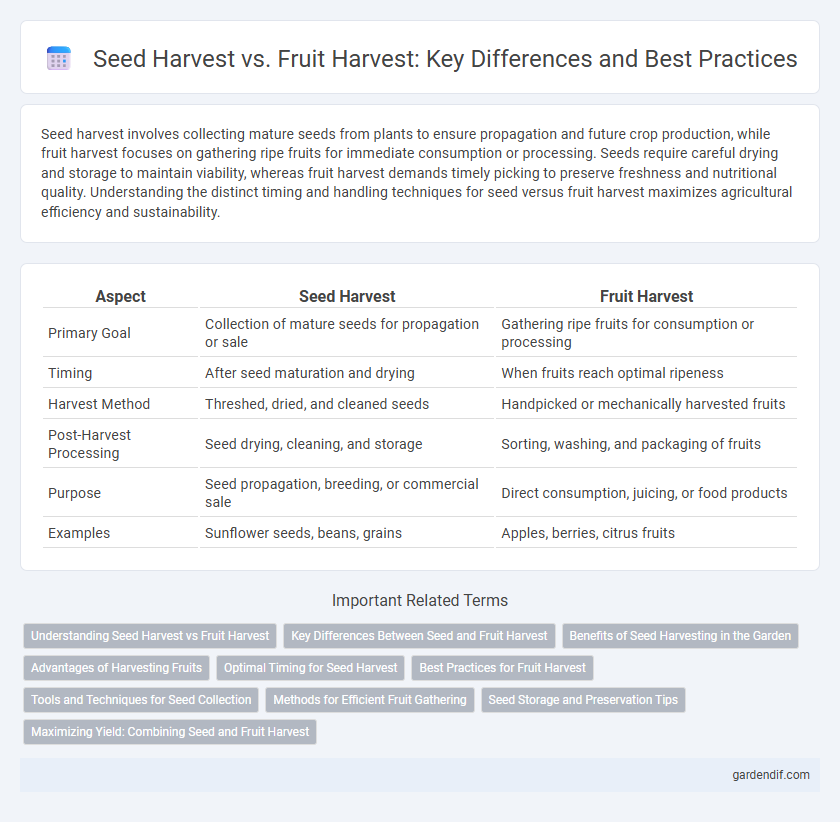
Seed Harvest vs Fruit Harvest Illustration
Seed harvest involves collecting mature seeds from plants to ensure propagation and future crop production, while fruit harvest focuses on gathering ripe fruits for immediate consumption or processing. Seeds require careful drying and storage to maintain viability, whereas fruit harvest demands timely picking to preserve freshness and nutritional quality. Understanding the distinct timing and handling techniques for seed versus fruit harvest maximizes agricultural efficiency and sustainability.
Table of Comparison
| Aspect | Seed Harvest | Fruit Harvest |
|---|---|---|
| Primary Goal | Collection of mature seeds for propagation or sale | Gathering ripe fruits for consumption or processing |
| Timing | After seed maturation and drying | When fruits reach optimal ripeness |
| Harvest Method | Threshed, dried, and cleaned seeds | Handpicked or mechanically harvested fruits |
| Post-Harvest Processing | Seed drying, cleaning, and storage | Sorting, washing, and packaging of fruits |
| Purpose | Seed propagation, breeding, or commercial sale | Direct consumption, juicing, or food products |
| Examples | Sunflower seeds, beans, grains | Apples, berries, citrus fruits |
Understanding Seed Harvest vs Fruit Harvest
Seed harvest involves collecting mature seeds from plants to ensure successful propagation and future crop production, emphasizing seed quality, moisture content, and proper drying techniques. Fruit harvest focuses on gathering ripe fruits meant for direct consumption or processing, prioritizing optimal taste, texture, and shelf life. Both types require careful timing and handling to maximize yield and maintain product integrity in agricultural practices.
Key Differences Between Seed and Fruit Harvest
Seed harvest focuses on collecting mature seeds from plants, ensuring optimal moisture content for viability and future planting, while fruit harvest targets ripe fruit for immediate consumption or processing. Seed harvesting requires careful drying and storage to maintain seed quality, whereas fruit harvesting emphasizes timing to preserve flavor, texture, and nutritional value. Differences also include methods and tools used, with seed harvest often involving threshing and winnowing, and fruit harvest relying on manual picking or mechanical harvesting to prevent damage.
Benefits of Seed Harvesting in the Garden
Seed harvesting preserves plant genetics, allowing gardeners to cultivate native or heirloom varieties adapted to local conditions. It promotes biodiversity by enabling the propagation of diverse species and contributes to sustainable gardening practices through seed saving. Collecting seeds also reduces costs and dependency on commercial seed sources while supporting long-term garden resilience.
Advantages of Harvesting Fruits
Harvesting fruits provides immediate consumption and market readiness, ensuring higher nutritional value and freshness compared to seeds. Fruit harvest supports premium pricing due to consumer preference for whole, ripe products with intact flavors and textures. This approach also reduces post-harvest processing costs linked to seed extraction and cleaning.
Optimal Timing for Seed Harvest
Optimal timing for seed harvest is crucial to ensure maximum viability and germination rates, typically occurring when seeds reach physiological maturity but before they begin to deteriorate. This stage varies by crop species but is generally identified by changes in seed color, hardness, and moisture content dropping to an ideal range between 10-15%. Monitoring environmental factors such as humidity and temperature also supports precise harvest timing, minimizing seed loss and preserving genetic quality.
Best Practices for Fruit Harvest
Fruit harvest requires careful timing to ensure optimal ripeness, maximizing flavor and nutritional value. Employing gentle picking techniques minimizes damage, preserving fruit quality and extending shelf life. Utilizing proper storage conditions such as controlled temperature and humidity further maintains freshness and reduces post-harvest losses.
Tools and Techniques for Seed Collection
Seed harvest requires specialized tools like seed drills, seed separators, and moisture meters to ensure optimal seed viability, while fruit harvest commonly employs handheld clippers, ladders, and collection baskets for gentle handling. Techniques for seed collection involve drying, threshing, and winnowing to separate seeds from plant material, contrasting with the manual picking and sorting methods used in fruit harvest. Precision in seed moisture content measurement and seed cleaning techniques directly impacts germination rates and crop yields.
Methods for Efficient Fruit Gathering
Efficient fruit gathering relies on careful manual picking to avoid bruising and maximize quality, using tools like ladders, picking bags, and clippers for precision. Mechanical harvesters are suitable for large-scale orchards, employing vibrations or shaking techniques to detach fruit without damaging the tree or produce. Timing is critical; harvesting at peak ripeness ensures optimal flavor, storage life, and market value, distinguishing it from seed harvest methods that prioritize seed maturity and extraction processes.
Seed Storage and Preservation Tips
Seed harvest involves collecting mature seeds at peak dryness to ensure maximum viability, while fruit harvest targets ripe fruit for immediate consumption or processing. Proper seed storage requires drying seeds to a moisture content below 8% and storing them in cool, dark environments with temperatures around 4degC to prolong dormancy and prevent fungal growth. Using airtight containers and periodic viability testing enhances preservation, contrasting with fruit harvest where freshness preservation relies on refrigeration and rapid consumption.
Maximizing Yield: Combining Seed and Fruit Harvest
Maximizing agricultural yield involves strategic timing and methods for both seed and fruit harvests to ensure optimal resource utilization and crop productivity. Seed harvest focuses on collecting mature seeds for propagation and future planting, while fruit harvest targets the edible or marketable parts of the plant, requiring precise timing to capture peak ripeness and nutritional content. Combining these harvests through integrated practices enhances sustainability by reducing waste and improving overall farm profitability.
Seed Harvest vs Fruit Harvest Infographic

 gardendif.com
gardendif.com